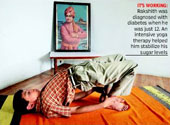01 July 2011
By, Jayashree Nandi
Bangalore, India
Nimhans Doing Clinical Trials To Prove Its Efficacy

Doctors at Nimhans say their studies reveal evidence of biological changes in the body brought about by yoga. They prescribe yoga therapy along with medication in major ailments, while using yoga therapy alone for less serious disorders. Nimhans is currently doing rigorous clinical trials on the impact of yoga in treatment. Doctors are also measuring biological parameters in patients after yoga therapy. This project has been taken up as the scientific community has still not accepted the role of yoga despite even mainstream doctors prescribing it with allopathic treatment.
“In all our investigations, there is a high degree of evidence that yoga in different forms does have a curative effect in diseases like depression, memory loss in elderly persons, schizophrenia and others. We worked out specific protocols for yoga for specific neurological problems. The degree of improvement is comparable to that of medicine,” said Dr B N Gangadhar, programme director, Advanced Centre for Yoga, Nimhans.
 IT’S WORKING: Rakshith was diagnosed with diabetes when he was just 12. An intensive yoga therapy helped him stabilize his sugar levels
IT’S WORKING: Rakshith was diagnosed with diabetes when he was just 12. An intensive yoga therapy helped him stabilize his sugar levels Treatment Training
The department of Ayush has launched a countrywide Stop Diabetes campaign. In it, we train yoga practitioners to treat diabetes patients. Extensive research over 20 years reveals that blood sugar reduces with yoga and good cholesterol increases. It has a calming effect on the body and mind. We have seen improvements in those suffering from hypertension, obesity, heart diseases, cancer
Dr R Nagarathna | Yoga Expert Case Study
The yoga university found evidence that it can reduce sugar levels and help control it in a case of juvenile onset diabetes Type 1 of 14-year-old Rakshith S. He suffered high sugar levels and severe glaucoma for 18 months but now his sugar level has stabilized, thanks to the 21 days of intensive yoga therapy.
Rakshith was diagnosed with diabetes at the age of 12 after complaints of giddiness and tiredness and being hungry all the time. In September 2009, he was diagnosed with fasting blood sugar level of 340 mg/dl and post-prandial blood sugar level of 525 mg/dl.
When he came to Swami Vivekananda Yoga Anusandhana Samstha University, his insulin dosage was 24 units in the morning and 24 in the evening. A holistic approach that included asanas, pranayama, suddhi kriyas or detox methods, meditation and sattvic food was put in place. But Rakshith had glaucoma in which the intraocular pressure rises, so he couldn’t do all the asanas. His therapist Rupali Ashok Zamvar said: We saw improvement and stability in his sugar level after therapy. His insulin dosage was gradually reduced. Diet also played a major role.”
Benefits of yoga
Nimhans has worked out 12 hypothetical leads, and for some, experts have found evidence.
- Yoga reduces cortisol levels (cortisol is a steroid hormone produced by the adrenal gland. It’s released in response to stress and low level of blood glucocorticoids)
- Yoga increases brain derived neurotrophic factor (BNDF). The protein encoded by this gene is a member of the nerve growth factor family. Expression of this gene is reduced in patients suffering from Alzheimer’s and Huntington. It may regulate stress response
- Yoga helps reduce TNF alfa (tumour necrosis factor)
Disclaimer: The news story on this page is the copyright of the cited publication. This has been reproduced here for visitors to review, comment on and discuss. This is in keeping with the principle of ‘Fair dealing’ or ‘Fair use’. Visitors may click on the publication name, in the news story, to visit the original article as it appears on the publication’s website.